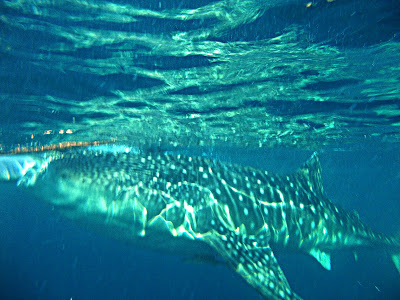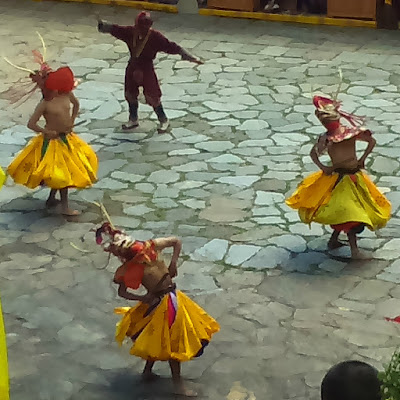I was awed when I first saw one years ago at an aquarium.
Now, I find myself swimming next to the world's largest fish in the ocean off the coast of the Philippines.
Whale sharks grow upwards of 45 feet and can weigh 20 tons.
It's a bit intimidating watching a
20-footer heading straight
towards me ...
it's five-foot wide mouth open, as if it could swallow me whole without much of an effort or a second thought.
But humans aren't on the menu. The whale shark uses it's cavernous mouth as a filter to consume plankton.
Fishermen in the village of Tan-awan – just outside of Oslob on the island of Cebu – once drove away the gentle giants because they destroyed nets and scared other fish. That is until a few tourists asked the fishermen to take them out to see the sharks. Soon, the fishermen discovered they could make a better living as tour guides and began daily feeding the whale sharks with krill to attract them.
Some environmentalists say that's to the nutritional detriment of the whale sharks who now prefer bobbing at the surface for handouts, rather than following their instincts to forage the open seas for more natural food.
In addition, the environmentalists say this behavior has changed the migratory patterns of the sharks,which could affect breeding. Finally, as the whale sharks have acclimated to humans, environmentalists say the fish now equate boats with food and are susceptible to injury, especially from boats with propellers.
The catamarans used to transport tourists to the feeding sights, located a few yards offshore, are powered by oars, but the whale sharks still sustain injuries.
Supporters of the whale tourism say it's boosted the local economy and raised awareness of the endangered fish, which were formerly hunted but now protected across Asia.
Tourism officials are also quick to point out that the activity is tightly controlled. Swimmers must undergo a briefing. They are no longer allowed to touch the fish, and violators face fines, including the possibility of jail time.
Snorkeling with the whale sharks isn't exactly a Jacques Cousteau moment – knowing that the fish are baited and having to avoid other tourists jockeying for position to get the perfect selfie – but there's still something thrilling experiencing a 20-foot fish circling around you.
PRACTICAL INFORMATION
- Tan-awan is located three and a half hours from Cebu City. Buses run throughout the day from the South Bus Terminal, The fare on an air-conditioned bus is 145 pesos (roughly $3 US). Ask the driver to let you off at the whale watching briefing area, a few minutes south of Oslob. If you prefer spending the night, there are plenty of accommodations in Oslob, as well as more limited lodging in Tan-awan. Public transportation from Oslob to Tan-awan is available for seven pesos via a jeepney.
- The fee for swimming with the whale sharks is 1,000 pesos (roughly $21 US), including snorkeling gear and a life vest. It's cheaper if you prefer staying in the boat. The session is limited to 30 minutes.
- Arrive early to beat the crowds. The viewing begins at 6 a.m.
- Consider spending a day or two in Oslob to experience the ocean, take in the Spanish architecture,
and enjoy a bit of culture.














